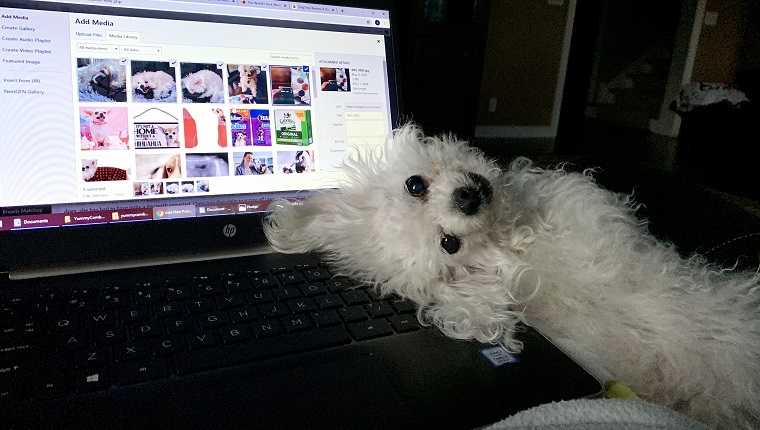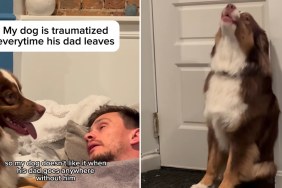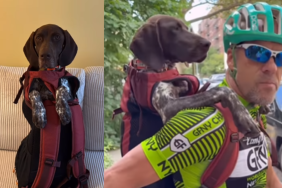I started researching the topic of separation anxiety in dogs because my day job will be bringing our department back to the office soon, and my work-from-home days for the last few months have looked pretty much like the picture above.
My dog, Leia, and I have been loving all this together time. Almost every waking moment, we’ve been together. This was a huge increase from our normal routine where I’d go to work every day and often attend social functions at nights or on the weekends.
Now that we’ve gotten word that our department is preparing for us to get back into the office soon, I’ve started to wonder if our super-bonding will have a bittersweet side.
I’m determined to strike a balance between relishing our last days of togetherness and preparing her — us! — for our normal days of my not being at home as much.
Here are some tips I’ve learned from my research. Hopefully, they can help you, too, whether you’re also looking at returning to the office soon, starting a new job, traveling, resuming work after a medical leave, or starting to leave home again for any reason.
How Do You Know If Your Dog Is Having Separation Anxiety?
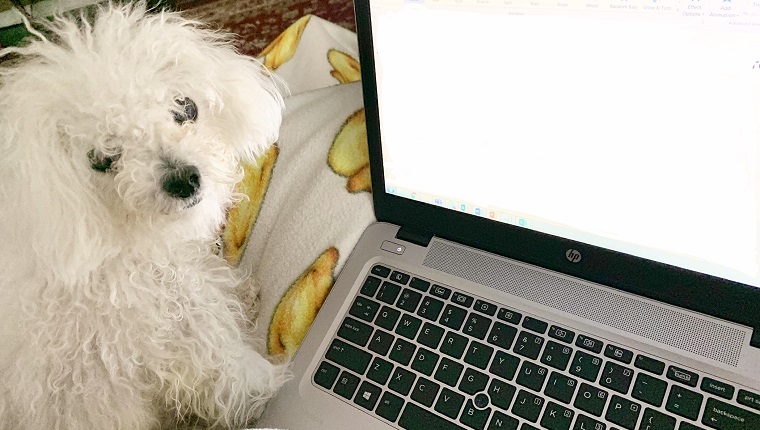
One of the reasons we love dogs so much is because they’re humans’ best friends. We’re used to them being by our sides and greeting each other with joy when we’re reunited.
Because of these natural behaviors, it may be confusing to know what’s normal for your dog versus what is separation anxiety.
Just like with people, there are varying degrees of anxiety for dogs. The term “anxiety” spans everything from fleeting emotions of worry/pining to medical conditions.
It’s not uncommon, either. According to the American Veterinary Medical Association, separation anxiety constitutes 20 to 40 percent of the diagnoses from animal behavior specialists in North America, and according to the American Kennel Club, around 14 percent of all dogs suffer from separation anxiety.
Behaviors can include:
- Excessive barking or howling
- Urinating or defecating in the house (when not due to another medical condition, like a bladder infection or older age)
- Destructive behaviors, like tearing or digging at items in the house
- Pacing, whining, or even trembling while you prepare to leave or while you’re gone
You can treat many of these or other anxious behaviors with a few tricks, which I’ll share below.
If your training tricks don’t work, and your dog is having major destructive or injurious meltdowns, you should talk to your vet and perhaps consider medication, supplements, or other devices that will help your dog stay calm and healthy.
Tips To Ease Separation Anxiety As You Go Back to Work
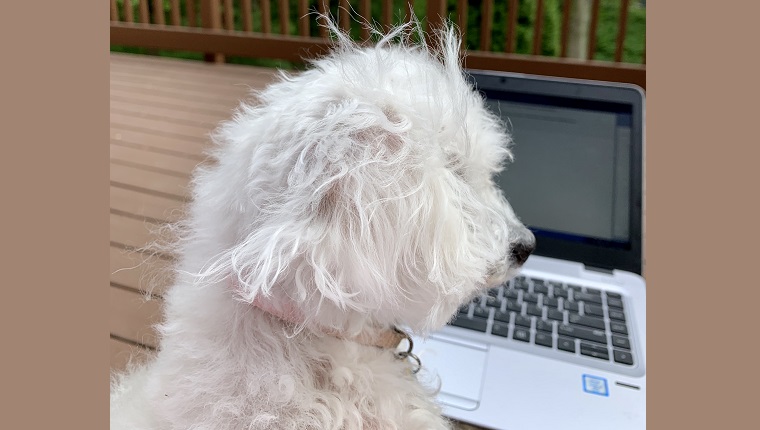
I’ve been feeling pretty guilty about leaving Leia at home more by herself now that I’ll be going back to work. Her dad is an essential worker, and thus, has not been working from home. However, it’s what she’s known most of her life, and it’s what she will have to get used to once again.
I’ve simultaneously been feeling guilty for encouraging so much together time, hoping that it won’t be too jarring or sad for her when I go back. After doing some research and practicing some of these tips myself, though, I’m feeling a little better and more prepared for when I go back to the office.
Indeed, experts recommend working now to establish a routine when you’re preparing your dog for your return to the office, one which is similar to what it will look like when you’re actually out of the house.
Here are five tips to ease your dog’s separation anxiety before you return to work:
1. Practice Leaving Home For Short Periods Of Time
I’ve hardly been going anywhere over the last few months, and half the time, when I do leave the house, it’s to see my family in their backyard. Leia comes with me and loves these trips.
I can’t tell you how guilty I felt when I discovered Leia thinks she’s going on a fun trip every time I pick up my purse. She would get excited, tail wagging, and then whine when she was left behind.
From experience and from reading about this tip, I’ve realized I need to leave the house a little more — oh, for so many reasons… — so now, she doesn’t come with me when I go to pick things up from the store, take out the recycling, etc.
It’s starting to become a little more normal for her, and she can adjust gradually, something experts recommend, versus a sudden shift in all time at home to much less.
2. When You Are Home, Practice Spending Time Apart
Oh, this one is hard for me. It’s hard for me not to scoop Leia up to put her on my lap every time I’m sitting anywhere. However, I realize spending some time apart is a good way to transition from her being “on her own,” or at least not needing constant attachment, to truly being by herself during the day.
At the same time, experts say it’s important not to withhold affection from your dog when you are together, as that could create more anxiety and confusion for them. So if your dog wants a cuddle or a petting while you’re at home, go ahead.
If you wander off into different rooms at some points, though, this is a good way to encourage independence.
3. Make Their Alone Time Fun
Providing your dog with something to do while you’re gone will help them not only to have something to focus on other than pining for you, but will also train their brain to understand that this part of the day is a good one.
If your dog enjoys chew toys, puzzle treat dispensers, and the like, consider leaving some out when you leave the house. That way, they can focus their energy and attention on something non-destructive.
4. Make Your Departure And Arrival A Positive Experience
Your dogs love earning treats and praise from you. It’s a win-win — they love having your approval, and who doesn’t love a treat?
Giving treats and praise are great ways to reinforce calm behavior with your dog. After I noticed Leia was whining — and breaking my heart — when I left the house, I’ve started giving her a small treat when I leave. She’s too busy devouring it to whine!
Similarly, when my husband comes home from work, my pup had gotten into the habit of barking up a storm, running and jumping all over the place, even whining. She could not contain her energy!
He started giving her offering her a small treat when he comes home, saying “No” until she calmed down, then praising her and giving her the treat once she was calm. Now, Leia knows how to be calm when we depart and arrive.
I hope she keeps up this good girl behavior!
5. Stay Positive!
We already know dogs are very smart and excellent readers of our moods. If you feel worried or very sad about leaving the house, your dog will likely pick up on this and feel the same way.
I am absolutely writing this last point with myself in mind, as I’ve already been feeling melancholy, knowing our time together will be lessened soon.
When you’re leaving the house, try to think and speak positively, and just keep in mind you’ll see each other at the end of the day.
It wouldn’t be a bad idea to give yourself something to look forward to, as well, like a cup of coffee or a favorite song to listen to for your commute, even if you can’t help crying into that coffee on the way to work — I’m speaking for a friend, of course.
It’ll help your dog if you put on a brave face before you leave.
Cherish Your Time Together!
I hope these tips help you minimize separation anxiety for your dog, and maybe for yourself. While there have obviously been many negatives of this pandemic, the silver lining for many pet parents has been increased time with our furry family members.
I, for one, will be cherishing memories of this extra cuddling time with Leia, as well as the hundreds of extra pictures I’ve taken of her, as I go back to the office.
I’m grateful for the extra time we’ve had together, and I’m also grateful we have a plan to work on getting us ready to go back to normal, or a version of it, anyway!
Do you have any tips on how to ease separation anxiety with your dog? Is there anything you’re doing to prepare them for your return to work? Please share in the comments below!
Click the bold links in the article to shop for your dog and support our content!
